News
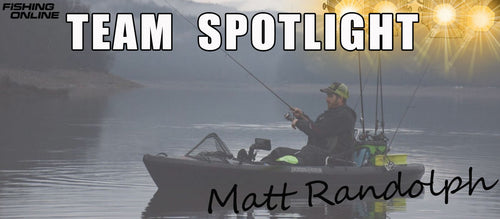
Fishing Team Spotlight: Matt Randolph
Matt Randolph has been bass fishing for over 20 years, with only the last five coming out of a kayak. He is known for catching some TANKS on the water, and he is always happy and willing to help out anyone. Check out some of his favorite places to fish, what he uses to catch those monster bass, and some of his favorite things to bring on the water.
1) What is your favorite fishery, and why?
My favorite fishery would have to be the Susquehanna River, hands down some of the best smallmouth fishing in the country. If any of you guys/gals know me, I am a smallmouth fanatic!
2) When it comes to weather, do you prefer warmer days or cooler days, and why?
When it comes to days that I prefer to fish, I definitely choose the cooler days over the warmer days. But, I guess it also depends on the time of year. For example, this weekend it's going to be 71 degrees (Perryopolis, PA), and in the winter, any type of warming trend can be crucial to a successful day on the water. 1 or 2 degrees means a lot this time of year; that is if you have open water. In the summertime, having a cooler day will definitely make the fish more active. There are a lot of factors you have to consider before making the right decision about the weather and fish patterns. The more time you spend on the water, the more you'll understand the weather and how it affects fish.
3) What is your all-time favorite setup (rod, reel, line, bait)?
Hands down, my favorite setup is my G. Loomis Bronzeback Med. Action 7'4" Rod, Shimano Stradic 2500 Ci4+ Reel, 8lb. Seaguar fluorocarbon Line, PB&J 1/8oz Z-Man skirted finesse jig with a PB&J Big TRD Trailer (rattle added) and, last but not least, a big old glob of Smell Jelly!
4) Are you more of a river angler or a lake angler?
I am definitely more of a river fisherman than a lake fisherman. Although I love both, I'm a river rat. I grew up fishing rivers, and there is nothing better than a 2-3 day float trip with your friends on your favorite river. Oh yeah, and did I mention 90% of the rivers in Pennsylvania have smallmouth in them?! Another reason why I prefer rivers. Not saying I don't like fishing lakes, I just like rivers a little more.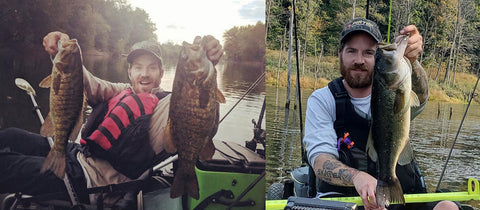
5) What does preparing for a tournament look like for you? From scouting locations to watch the weather to the baits you’re choosing, etc….let us know!
Getting ready for a tournament consists of a lot of Navionics maps studying, and I will usually start looking at the weather patterns two weeks, sometimes 3 or 4 weeks before a tournament. It all depends on what time of year it is. Summertime, I mainly study Navionics and wind directions. Spring, fall, and winter, I will look at water temps more than anything else. To have a significant advantage is being familiar with the body of water you're fishing. When fishing new waters, look at Navionics and find areas where bass will be staging. You can always find fish near deep channel ledges even if it means fishing 35'+ water. Sometimes getting out of your comfort zone will benefit you in the long run. With all of that being said; now it's time to choose your bait.
I always find that a small jig presentation will catch fish all year round. Tweaking it for the condition (rattle, dye, fish attractant, lure weight, hook size, etc.) Having multiple rods is key when tournament fishing. From being able to grab a chatter bait in 10 seconds to throw at a busting fish to grabbing a whopper plopper and throwing it at a pack of 19" smallmouth, the ability to have that option will catch you more fish. Having the right rod and reel setup is crucial. Nothing worse than having a giant bass get off because of a gear malfunction/failure. It happened to me a lot as a kid, and I learned that you get what you pay for. I understand everyone can't afford to buy $300+ reels and $500+ rods, but do yourself a favor and save your money by purchasing a good rod and reel instead of purchasing the $50 reel/$50 rods that will possibly cause you to lose some sleep. You guys/gals know what I'm talking about.
6) Even though it may depend on the time of year, and what the water looks like, do you have a favorite color to throw no matter what?
My all-time favorite color would have to be a green pumpkin. I've caught over 30 citation smallmouth and over 15 citation largemouth in PA on a green pumpkin. Clear/dirty water doesn't make a difference; green pumpkin will catch you fish.
7) What is one suggestion you have for anyone that is looking just to start getting with kayak fishing?
To all the newcomers to kayak fishing, my one suggestion would be to have the right kayak for your style of fishing. For example, I have four kayaks, and all 4 have a purpose for different water. Do some research, find what you're interested in, and find a way to demo one for a day. There is nothing worse than buying something you are not going to like. Always keep in mind if you will be fishing more rivers or lakes. That will be the most crucial part of choosing a kayak.
8) Besides the obvious (paddle, PFD, rods & reels, baits), what is one thing that you always have on your kayak with you?
One thing I always have in my kayak besides the obvious... this is a tough one. Smelly Jelly!!! I know that's kind of obvious but, I won't leave the bank until I find my smelly jelly!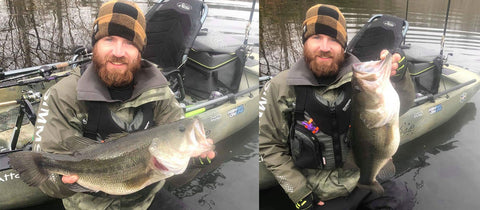
9) Do you have a favorite accessory, and is there any particular reason that is your favorite?
My favorite accessory would have to be my NRS Ambush crate. I added 2 extra rod holders to the side for more rods. It also zippers up and is pretty much waterproof. 10 out of 10 in my book!
10) If you are struggling on tournament day, what is something that you do to try and change that?
During tournament struggles, I found that sticking to your comfort bait will help you get out of a funk. Always be thinking that the next cast could be the one. And in all fairness, that's the truth. Always try and have a positive attitude, even if the struggle is real. Keep your head down and grind it out.
11) What made you want to get into kayak fishing in the first place?
A good friend of mine and a good friend of the kayak community Russell Johnson. He was the main reason I started kayak fishing. I've always been a fisherman, but usually out of canoes and boats and a lot of wade fishing. He is the one that got me in a kayak and I was hooked for life. (Thanks, Russ!) Getting into kayak fishing is unlike any other sport I've been apart of. We are all here to help each other out and look out for one another. I'm proud to be a part of the kayak community.
12) What is one of your goals for the 2020 season?
My one goal for 2020...that's an easy one...catch big fish!!
13) Where is your dream fishing spot?
My dream fishing spot is the Susquehanna River, even though it's a reality for me!
14) If you could spend a day fishing with anyone, who would it be? (this can be someone you know, a professional angler, anyone!)
Rick Clunn.
15) Do you have a favorite technique to use, or are you comfortable with many different ones and switch it up depending on the day/location?
My favorite technique is definitely jig fishing, but I'll change baits till I find what is making them react. Then I will mess with colors until I see what they really want. I am starting to become more and more comfortable with several different techniques that I've been practicing for the last 25 years. Still trying to master them, though!
16) You seem always to be catching giant fish; do you think it’s more of knowing exactly what to throw or knowing specific spots that always produce big fish, or a combination?
I know a few of the giants I have caught over the last few years were plain old luck, but over time you start realizing fish migration/patterns, and then you add the conditions to the equation and make educated guesses where the fish will be. When you factor in everything, you are giving yourself the highest percentage of catching a big fish. I've read so many books/articles it's not even funny. They will help you understand what bass should do. The key is figuring out what they are actually doing. There is a lot of useful information out there, but there is also a lot of lousy information. Make sure you do your research and get on the water to put your theories to the test.
Thank you for reading our blog; we hope you enjoyed it!
- FishOn ProStaff
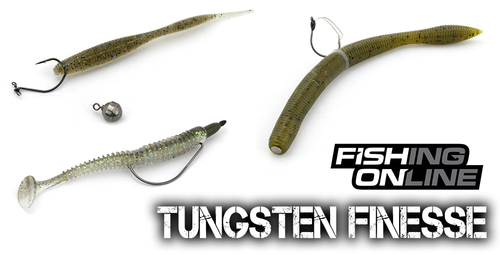
Top 3 Tungsten Finesse Fishing Rigs
Top 3 Tungsten Finesse Rigs
When we are talking finesse, we are talking light line, small hooks, small weights, small everything. For line and hooks, we can simply use lighter strengths and smaller sizes respectively. Lures? Use smaller plastics. When it comes to weights, if you want smaller, you must go with Tungsten. Tungsten is much denser than the widely used lead weights and therefore has a much smaller profile. This makes it perfect for finesse rigs! So, without further ado, here are some of my favorite finesse style presentations using Tungsten weights.
Drop Shot Rig
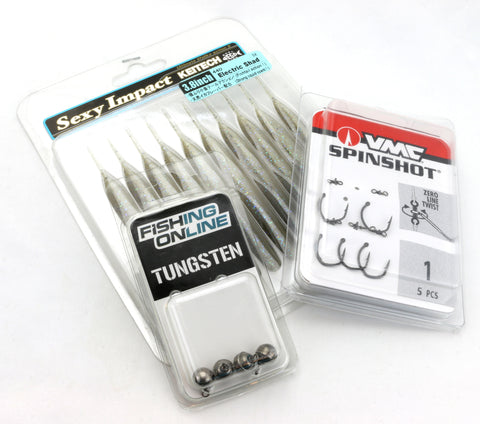
The ol’ tried and true drop shot flat out catches fish. My go-to setup is a 10 lb braid mainline to a 6 or 8 lb fluorocarbon leader. I like to use a size 1 VMC Spin Shot hook, Fish On Tungsten Round or Cylinder weight (weight depends on the depth and current), and a drop shot style plastic. I like Keitech’s Sexy Impact or Strike King’s Dream Shot the most. The deeper I’m fishing, the heavier I’ll go. Anywhere from ¼ oz up to 1 oz. The reason I like Fish On’s Tungsten Round Weight for the drop shot is because of its ring eye. Most drop shot weights feature the quick pinch-style connection. Tungsten costs more than lead and I tend to lose more weights with the pinch style and therefore lose more money. When a snag occurs the pinch-style tends to pull the weight off the line. I more often than not can free my snag with the ring eye by messing with it. However, to avoid losing my whole rig on those serious snags, I will often tie a lighter line going from the bottom of my Spin Shot hook to the weight. So, if I’m using an 8lb leader, I’ll use 4lb or 6lb going from the bottom of the hook to the weight. This way if my weight gets snagged, I can break off just the weight and not my hook.
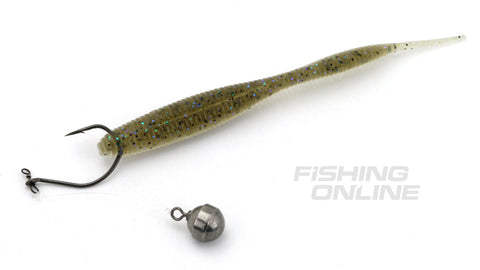
Swimbait Rig
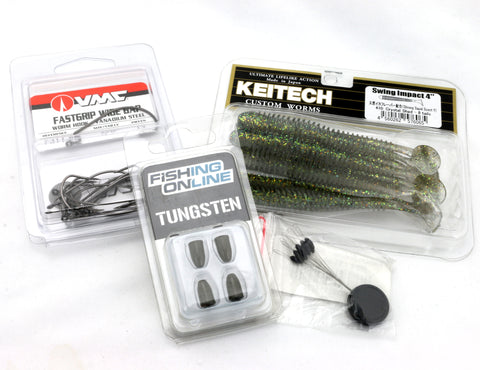
Small paddle-type swimbaits might be one of my favorite ways to fish due to their versatility. You can drag them slowly along the bottom or rip them fast along the surface. I really like working them in and around weed edges, lily pads, docks, and various types of structure. To help create a nice smooth presentation, I’ll use a Fish On Bobber Stop, a Fish On Tungsten Worm Weight (usually 1/16th oz), a Keitech 4” Swing Impact, and a VMC 2/0 Fastgrip Wide Gap Hook. With the bobber stop's shape combining with the worm weight's shape to make a narrow point, this lure slides in and out of weeds flawlessly and gets where the fish are without getting hung up.
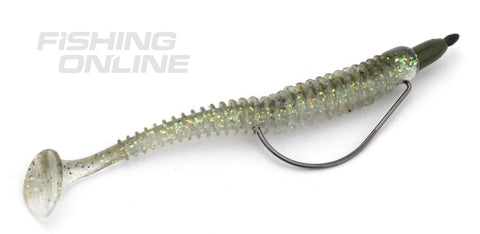
Neko Rig
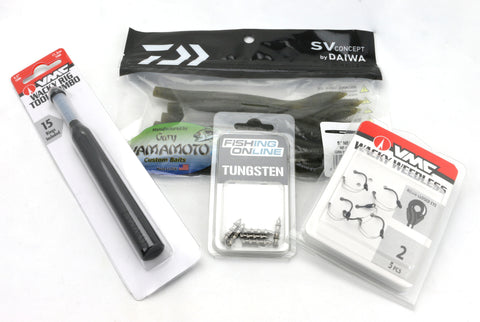
I love the Neko Rig’s action and the results I get when I fish it. Around rocky and hard bottoms, the Neko Rig has landed me some incredible Bass. For this rig, I like the Fish On Tungsten Nail weights, Daiwa/Gary Yamamoto Fat Neko Worm, a weedless or regular size 2 VMC Wacky Rig hook, and a VMC Wacky Rig O-Ring tool. This rig looks awkward as can be but the way the bait twitches and bounces along the bottom, Bass just can’t resist.

For all three of these rigs, I like to use a Medium Light style rod, something like the Dobyns Champion XP DC682SF, a 2500 size spinning reel, 10 lb braid mainline, and 8lb fluorocarbon leader. I’ll downsize the leader line on those painfully slow days or in ultra-clear water but for the most part, this is my go-to setup for finesse fishing. Each of these styles of fishing has its place and can be a solid producer in the right conditions. Adding them to your arsenal can provide some real benefits, so make sure to give them a shot and see for yourself!
Thank you for reading our blog; we hope you enjoyed it! Have a great day and Fish On!
- Seth Willoughby

How to Fish for Musky
You asked for a more in-depth look at the techniques used on Erie Extreme TV, so we've partnered with Dave Lefebre and the rest of the crew to bring you a new segment called In-Depth Look! We're breaking down on the main products and techniques featured in each segment to help diehard fishing fanatics like yourself learn tips and tricks straight from the pros!
Check out this week's In-Depth Look at How to Catch Musky: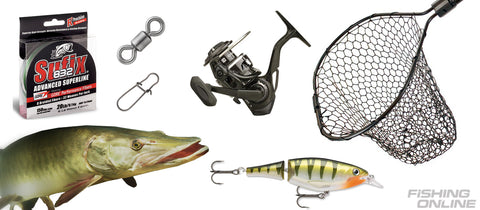
After Spring, Mark Grazinao and Dave Lefebre say the best places to find musky are in post-spawn shallow weed beds. At this time musky are feeding on perch and larger baitfish, so using a life-like jointed swimbait will help rouse up the musky's attention. Here's a look at Mark and Dave's equipment set up:
Lure: Rapala Jointed X Rap, Model #13, 5 1/4 in, Color-Perch
Rod: 13 Fishing Defy Black / 7 ft / Medium
Reel: 13 Fishing Creed X / Model 2000 / 5.2:1 Gear Ratio
Line Leader: 50 LB Sufix Advanced 832 Braid Invisiline Fluorocarbon
Tackle: VMC 1/0 Swivel and #3 Snap
Musky are iconic for being patient hunters and they will follow bait for a long time. Retrieve your lure in a jerk-jerk-pause cadence. Once you get your lure close to the boat and/or kayak, put the tip of your rod down in the water and make a figure 8 pattern. If a musky has been hunting (aka following) your bait, the figure 8 pattern of the lure can prompt an immediate strike!
You can also troll for musky. When trolling, Mike and Dave's boat speed was roughly 3.5-4 mph. Keep your lure only 20 feet behind your boat or kayak. Sometimes the churn-up of the water behind your boat and kayak can attract musky. Once you've sunk your hook into one of these monsters, don't rush the battle! Just hang on, let the fish do what it wants, and eventually, they'll tire themselves out.
Now be aware that most muskies aren't lost during the retrieve battle, but lost right when you get them to the boat/kayak. Make sure you have a good-quality, large, extendable net ready to scoop your musky up before they can flip off your hook. Another advantage of having a large net is that you can leave the fish in the water while you work on safely removing your hook(s). Once the hooks are out, you can pick up your fish, snap some photos of your prize catch, and release it back into the water.
You can utilize discount code ERIEEXTREMETV to receive 20% OFF most of the products featured in this segment. We hope you've enjoyed this week's In-Depth Look! Tight lines and as always, Fish On!
- Erica Novak
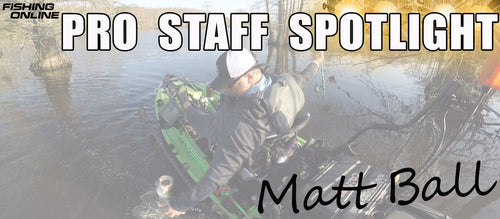
Pro Staff Spotlight: Matt Ball
Matt Ball grew up fishing in West Virginia with his father and now continues to pass on that love of fishing with his children. Matt has been kayak fishing for years, but put his name on the map when he was crowned the first-ever Kayak Bass Fishing National Champion in 2016! Since then, Matt has continued fishing tournaments all over the US and showing everyone that he was not a one-hit-wonder! Take a look at some of Matt's favorite techniques, his goals for the 2020 season, and how having the title of first-ever KBF National Champion has made him feel ever since.
1) What is your favorite fishery, and why?
This is a hard one. I have so many amazing places that I have traveled over the past 4-5 years that are very special to me. Kentucky Lake will always have a special place in my heart as that is where I won the National Championship in 2016. But, if I had to name just one place that I get excited about fishing every season, it would have to be Lake Erie. There is nothing like solving the puzzle of that massive body of water and being rewarded with football-sized Smallmouth. Using my Lowrance to find the smallest details or variances in the lake and finding fish is so rewarding.
2) When it comes to weather, do you prefer warmer days or cooler days, and why?
I don't really concern myself with what type of weather I will be fishing. To be a successful angler, you need to fish all kinds of weather patterns. For me, this is what makes fishing so enjoyable. I love the challenge of trying to figure out what the fish are doing on any given day. It is rare to fish a tournament and have the weather for pre-fishing line up perfectly with the weather on tournament day. I like to spend as much time as I can on the water in all conditions, so I have some knowledge of what to expect on any given day. Now, if we are talking seasons, that is a different story. Most people love the spring-time spawning. Don't get me wrong, I enjoy it just as much as the next guy; but if I had to choose a season that was my favorite, it would have to be Fall. Finding schools of fish feeding up for the winter can be some of the most action-packed days you will ever have on the water.
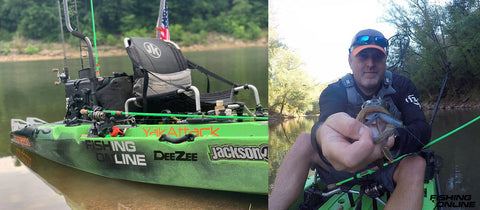
3) What is your all-time favorite setup (rod, reel, line, bait)?
I am a finesse fisherman at heart. If I could only have one set up on the water, it would be spinning gear. My setup would be a 13 Fishing Prototype X spinning reel in the 2.0 size on a 7'1" 13 Fishing Muse rod in Medium-Heavy action. I can use that rod to catch fish any time of the year. I like to use 20lb Power Pro braid with a 6 to 8-foot leader of Seaguar InvizX. If I am fishing Lake Erie in crystal clear water, I will use 6 or 8-pound fluoro. If I am fishing Lake Guntersville in the grass, I will go straight braid. I keep a variety of leader material on hand at all times and will switch up the line diameter depending on the watercolor and cover.
The reason I like the Medium-Heavy action is because of the versatility of the rod. I can throw a drop shot on Lake Erie or turn around and use that same rod with heavier line and fish a drop shot in the grass and have enough backbone to rip it through the grass and bring a fish out of the cover. It is just a great all-around rod for the do-everything setup.
4) Are you more of a river angler or a lake angler?
I grew up fishing rivers, and I would say that is where I am the strongest. If I am just going out fishing for fun close to home, though, I will choose a river over a lake every single time.
5) What does preparing for a tournament look like for you? From scouting locations to watch the weather to the baits you're choosing, etc...let us know!
Tournament prep for me starts months in advance. If I am fishing new water, my initial time is spent gathering all the information I can possibly find about that area. I pour over Google Earth, Navionics, YouTube, magazine articles, and just about anything else I can get my hands on. The next step is finding any access points onto the water. Anywhere that I can find to launch my kayak, which gives me the closest access to the area of the lake that I am planning on fishing, is what I am looking for. Finding that 'off the map access point that' is hard to get to can mean the difference between having an area to fish that is not crowded and fishing with 15 other anglers in the same area.
Once I get to a lake for a tournament, I try to get to as many locations as I can while pre-fishing to try and figure out a pattern and locate the best fish possible. I like to have three good locations to call upon for tournament day that has a little something different about them. This gives me options in case I run into weather changes, pattern changes, or just show up to an over-crowded area. The night before a tournament, I like to have everything laid out and ready to go for the morning. I have re-tied all my rods, checked all my gear, organized my boat, and have anything I need to take with me laid out and ready to roll for the morning. I do not like getting up in the mornings, so I don't want to have to do anything other than get to the ramp, get my boat on the water and be ready for the first cast. I use any free time that morning to get my head straight and take the time to pray for the event and all the anglers on the water.
Check out this video from Matt Ball giving an in-depth look of how he preps for a tourney:
6) Even though it may depend on the time of year and what the water looks like, do you have a favorite color to throw no matter what?
I find myself throwing green pumpkin the most in my plastics, white on most all of my chatterbaits and spinnerbaits, and either a crawfish color or shad color in any crankbaits I throw.
7) What is one suggestion you have for anyone that is looking just to start getting into kayak fishing?
Test out as many kayaks as you can before buying one. Everyone is different, and no kayak is perfect for everything. Find one that you are comfortable in for long periods, and that you can handle easily. Make sure to get a good, comfortable PFD and a good, lightweight paddle.
8) Besides the obvious (paddle, PFD, rods & reels, baits), what is one thing that you always have on your kayak with you?
My cell phone. It is one of the most critical items for the tournament angler. Without it, you are done. I use it for Navionics, TourneyX, weather, safety, and taking good pictures.
9) Do you have a favorite accessory, and is there any particular reason that is your favorite?
I have to say my Torqeedo Ultralight 403 is my favorite accessory. This motor has changed the way I fish more than anything else, and I can cover so much more water and save myself so much time. It allows me to fish rivers solo by going upstream for long distances and floating back to my truck without a shuttle. On a lake like Erie, I can cover so much more water while running my sidescan and locating the right depth that the fish are relating to. For tournaments, I can use it to eliminate a lot of water during pre-fishing and find fish in a shorter amount of time.
10) If you are struggling on tournament day, what is something that you do to try and change that?
When this happens, and it happens a lot, I like to pull over to the side of the lake and reorganize my kayak. Often when you are struggling, you have quite the mess in the boat. I like to clean things up, regroup, and take time to think about all that I have learned up to this point. I also like to take time to pray and just ask for peace, calmness, and acceptance for whatever the outcome of the event. Taking time to pray and regroup can do wonders for me, and I do it all the time.
11) What made you want to get into kayak fishing in the first place?
I started kayak fishing to fish the rivers and small streams more effectively. It then didn't take me long to realize the benefits of using the same kayak on the bigger lakes around my hometown. It just grew from there!
12) What is one of your goals for the 2020 season?
Have Fun! Seriously, if I am not enjoying what I am doing, I need to stop. I can set all the goals in the world, but if I am not enjoying myself, then what is the point.
13) Where is your dream fishing spot?
Anywhere that there is big smallmouth bass.
14) If you could spend a day fishing with anyone, who would it be? (this can be someone you know, a professional angler, anyone!)
My Dad. He got me into this sport at a young age, and I learn new things from him every time we fish together. The other would be my wife and kids. I love to see them out in the kayaks enjoying the sport that I love.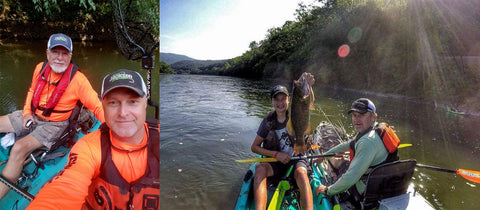
15) Do you have a favorite technique to use, or are you comfortable with many different ones and switch it up depending on the day/location?
I am comfortable with most techniques. By fishing tournaments all across the country, I have had to learn how to adapt. That being said, my confidence baits are the shaky head and the drop shot. If I am struggling and not finding success, I generally slow down and use one of those two techniques and usually find success. Both of these techniques will catch fish everywhere. I can drag a drop shot around on Lake Erie in 30 ft of water or drag it through the grass on Lake Guntersville and catch quality fish. If I'm honest, the shaky head has probably put more fish in my boat than any other technique. For this, my go-to is a Z-man soft plastic in either a Big TRD or a Hula Stick on an Owner Ultra-Finesse head.
16) As for being the first-ever KBF National Champion, do you feel an added layer of pressure to perform well at any given tournament?
Yes, it certainly has added pressure. The first year after winning that event, I knew that all eyes were going to be on me. I felt as if I needed to prove that I was not just a one-hit-wonder. I put a lot of pressure on myself to perform well in any event that I entered. I have been very blessed with consistency since that big win. The pressure is not only on how you fish after a big win like that but with that win came a lot of incredible sponsorship opportunities. For me, this was something that I didn't take lightly. I felt that if a company wanted to support me, I needed to give them a return on their investment. This takes time and effort to build that relationship with sponsors. Just having a logo to put on my kayak or jersey wasn't something that I was looking for. I wanted to be a part of those companies that I used and believed in.
All that being said, the most significant pressure that came with this win was one that I put on myself. I saw the opportunity with the national platform that the Lord blessed me with to use it for his glory. I knew that this opportunity came from him, and I wanted to glorify him through this. That is something that I, to this day, still feel the need to improve and build. I want people to know that He is who defines me, not what kayak I fish from, or what companies I represent.

We hope you enjoyed reading our blog! Have a great day and Fish On!
- FishOn ProStaff

Tips for Bass Fishing with Live Bait
You asked for a more in-depth look at the techniques used on Erie Extreme TV, so we've partnered with Dave Lefebre and the rest of the crew to bring you a new segment called In-Depth Look! We're breaking down on the main products and techniques featured in each segment to help diehard fishing fanatics like yourself learn tips and tricks straight from the pros!
Check out this week's In-Depth Look at Bass Fishing with Live Bait:
Bass fishing with live bait? Here are some tips straight from Dave Lefebre on how to maximize your hook-ups! First, make sure you hook your bait correctly. One of the main keys to successful live bait fishing is to make sure you bait stays alive, so it's recommended to skin-hook them through the lips or just under the dorsal fin, just make sure not to go too deep. A rule of thumb for your hook gap is that it should match the width of the baitfish that you are using. Dave's go-to hooks are the VMC Wacky Hooks. He uses a #4 for small shiners when Crappie or Perch fishing, and up to a 3/0 when Walleye fishing.
Second, Bobbers and Floats are great tools to utilize when live bait fishing. They provide extra weight for casting and indicate when you are getting a bite. Dave prefers to use the smallest float possible, so as not to alert the biting fish to something unnatural.
Thirdly, it's important to use a monofilament line, and not fluorocarbon, when bobber fishing, because of fluorocarbon line sinks and monofilament line floats. Dave will use anywhere from 4-12 lb test monofilament, depending upon the species you're fishing for. You can also use small weights to keep your bait down. Removable Split Shots work perfectly for this application.
Seeing a bobber go down can be one of the most exciting things in fishing, but try to resist the urge to set the hook too fast. Let the fish run with your bait to ensure that the bait is fully in its mouth, then pick up the line slack, set the hook and reel 'em in!
Lastly, you need a good spinning rod and reel. Dave suggests not compromising on your rods and reels just because of your live bait fishing. You can get high-quality spinning products for an extremely low price. Dave prefers to use the 13 Fishing Defy Rod and Creed K Reel for the ideal, all-purpose combo that is great for multiple different fishing applications.
You can utilize discount code ERIEEXTREMETV to receive 20% OFF most of the products featured in this segment. We hope you've enjoyed this week's In-Depth Look!
Thanks for reading our blog! We hope that these tips and tricks help fuel your success on the water. Now grab some friends and your gear and get out there and Fish On!
Receive 20% OFF of specific products and similar products featured in this episode with promo code ERIEEXTREME TV:
- Erica Novak

Shallow Water Crappie Fishing
You asked for a more in-depth look at the techniques used on Erie Extreme TV, so we've partnered with Dave Lefebre and the rest of the crew to bring you a new segment called In-Depth Look! We're breaking down on the main products and techniques featured in each segment to help diehard fishing fanatics like yourself learn tips and tricks straight from the pros!
Check out this week's In-Depth Look at Shallow Water Crappie Fishing:
Just after the ice-out, Crappie tend to hide in or be around some type of shallow water cover. That's why Dave Lefebre and Danny Jones like to head out on Pymatuning Lake to areas that have lily pad stems and stick-ups for some fun Crappie bobber fishing. For successful Crappie fishing during dingy-water conditions, you'll want to use bright colored baits, such as chartreuse. Here's a look at Dave and Danny's gear and set-up:
Bait: Chartreuse Tubes and Grubs
Jig Head: 1/32 oz VMC Neon Moon Eye Jig Head
Rod: 13 Fishing Defy 7ft Light
Main Line: Sufix Nanobraid 8lb Test
Leader: 10-12 ft Sufix ELITE Monofilament 4-6 lb test
Bobber: Weighted Float; Push Button Tubular
Anchor: Power-Pole Micro Anchor
Monofilament line floats, so it works better compared to the braided line when you're bobber fishing. To start your set-up, you'll have to set your bobber to the depth that your fishing. For example, in this week's segment, Dave and Danny are fishing in 2 feet of water, so they set their bobber at roughly 1.5 feet above the bait. And whether you're in a small boat or a kayak, Power-Pole Micro Anchors work really well for any shallow-water fishing conditions to keep you in the desired spot.
The retrieve technique is quite simple: you just cast it out, let it sit, and give it a couple of twitches here and there to stir up some movement. When you get a bite the weighted float will either submerge under the water or pop up. After you get a bite, just set the hook and reel them in. Crappie are referred to as 'Paper Mouths,' because they have really thin lips, that's why it's always a good idea to have a fishing net nearby so you never lose one once you get it near the boat.
Dave and Danny don't deny that bobber fishing for Crappie is about as fun as it gets. And the best part is anyone can do it, so it's the perfect opportunity to get the whole family involved! So get out there and Fish On!
You can utilize discount code ERIEEXTREMETV to receive 20% OFF our in-stock products featured in this segment. We hope you've enjoyed this week's In-Depth Look! Tight lines!
- Erica Novak





